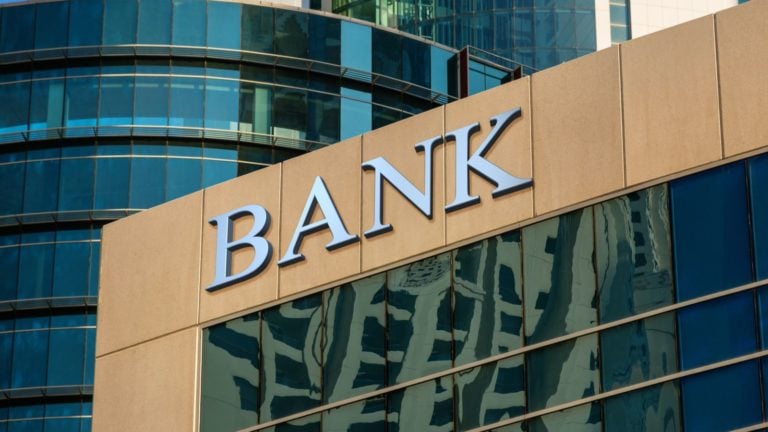In some respects, bank stocks sparked the recent market rally. These companies are the first to report earnings, with third quarter earnings reports coming at the start of October. Accordingly, largely positive results from leading U.S. lenders eased the concerns of many investors and traders, helping to improve sentiment after an abysmal September.
Consequently, the S&P 500 bank index is up 9.59% for the month of October, at the time of writing. The broader S&P 500 index, that serves as a benchmark for the entire stock market, has climbed 7% higher over the last month. That’s its strongest performance since January of this year, before interest rates began rising and before Russia attacked Ukraine.
With bank stocks seeming to want to continue this bounce, let’s take a look at three of the best bank stocks to buy following Q3 earnings.
| JPM | JPMorgan Chase | $125.88 |
| WFC | Wells Fargo | $45.99 |
| GS | Goldman Sachs | $344.51 |
JPMorgan Chase (JPM)

First on our list is one of the most highly-regarded bank stocks out there. Investors in JPMorgan Chase (NYSE:JPM) own shares in the biggest lender in America with nearly $4 trillion of assets under management. In fact, JPMorgan is the largest bank in the world, with a market capitalization of roughly $370 billion.
JPMorgan Chase was one of the first banks out of the gate with Q3 earnings, and its results did not disappoint. For the July through September period, the bank reported earnings per share of $3.12, handily beating Wall Street estimates for $2.88. Revenue in the quarter totaled $33.49 billion, beating the $32.1 billion that was expected by analysts. This top-line number represented 10% year-over-year growth.
JPM earnings, which serve as a bellwether for the banking industry and economy, bolstered sentiment among investors, especially as the lender stressed that consumers and businesses appear to be holding up despite indications of a slowing economy. And while JPMorgan’s investment banking and equity trading units experienced a slowdown in Q3, the bank offset those declines with greater interest income generated from higher interest rates charged on its loans, and also through a bump in bond trading.
JPM stock is currently down about 20% on the year at $126.08 per share. However, the bank’s share price has gained 19% in the past month.
Wells Fargo (WFC)

Another U.S. bank that issued a strong Q3 print was Wells Fargo (NYSE:WFC). The San Francisco-based lender is the fourth-largest bank in the U.S., with $1.71 trillion of assets and a market cap of nearly $175 billion. In Q3, Wells Fargo reported much better results than had been anticipated. Earnings per share of $1.30 blew past Wall Street forecasts for $1.09, and revenue of $19.51 billion was much better than the $18.78 billion that analysts had called for from the lender.
As the most mortgage-dependent of the big banks, Wells Fargo’s Q3 results were dinged by a 52% decline in its mortgage business, as activity in the housing market continues to decline. Much of this has to do with the average 30-year mortgage rate now at a 20-year high of 7%. However, Wells Fargo managed to overcome this underperformance in mortgage lending by posting a 29% increase in its commercial real estate division. Additionally, higher interest rates charged on its myriad of loans to both consumers and businesses buoyed the company’s results.
Wells Fargo executives emphasized that they are experiencing historically-low loan delinquencies right now. This comes despite concerns that the U.S. economy could tip into a recession in coming months. Thus, investors have another vote of confidence when it comes to the strength of the consumer, reflected in these data.
WFC stock is down 9% on the year, but its shares have rallied 14% in the last month, including a 3% uptick immediately after its Q3 numbers were made public.
Goldman Sachs (GS)

Looking beyond commercial lenders to investment banks, Goldman Sachs (NYSE:GS) is the one to buy. The New York-based company is the second-largest investment bank in the world after JPMorgan Chase’s deals unit, with annual revenue of nearly $34 billion and a market capitalization of approximately $117 billion.
As is typical, Goldman’s third-quarter earnings beat Wall Street forecasts by a country mile. The financial giant reported Q3 earnings per share of $8.25. Analysts had expected $7.69 a share, according to Refinitiv data. Revenue totaled $11.98 billion, versus $11.41 billion that was forecast. Executives at the bank attributed the strong showing to a boost in the company’s bond trading division.
Goldman said its bond trading revenue growth offset much of the weakness the lender saw in other areas of its business. Notably, the company underperformed in its investment banking unit, which is focused on initial public offerings (IPOs) and mergers and acquisitions (M&A). Despite revenues which fell 57% in the bank’s investment banking segment, the company’s bond trading unit generated $3.53 billion in revenue for Goldman Sachs, a 41% increase from a year earlier.
Thus, this Q3 print was the latest example of how Goldman Sachs, widely-viewed as one of the world’s most influential investment banks, manages to go from strength to strength in any operating environment.
GS stock remains down 14% this year and trading at $342 per share. However, the stock has jumped 15% higher during October, following its Q3 print.
Disclosure: On the date of publication, Joel Baglole did not have (either directly or indirectly) any positions in the securities mentioned in this article. The opinions expressed in this article are those of the writer, subject to the InvestorPlace.com Publishing Guidelines.
